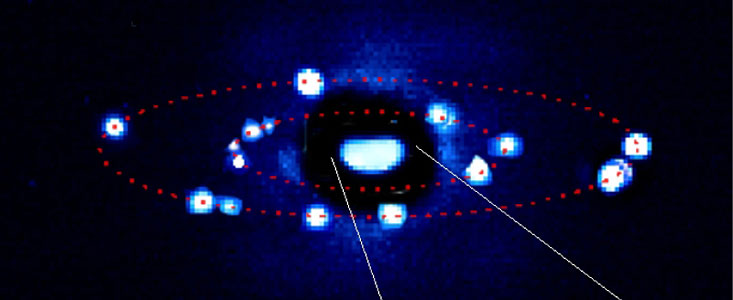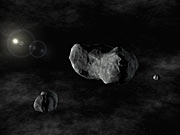Press Release
Rubble-Pile Minor Planet Sylvia and Her Twins
VLT NACO Instrument Helps Discover First Triple Asteroid
11 August 2005
One of the thousands of minor planets orbiting the Sun has been found to have its own mini planetary system. Astronomer Franck Marchis (University of California, Berkeley, USA) and his colleagues at the Observatoire de Paris (France) [1] have discovered the first triple asteroid system - two small asteroids orbiting a larger one known since 1866 as 87 Sylvia [2].
"Since double asteroids seem to be common, people have been looking for multiple asteroid systems for a long time," said Marchis. "I couldn't believe we found one."
The discovery was made with Yepun, one of ESO's 8.2-m telescopes of the Very Large Telescope Array at Cerro Paranal (Chile), using the outstanding image' sharpness provided by the adaptive optics NACO instrument. Via the observatory's proven "Service Observing Mode", Marchis and his colleagues were able to obtain sky images of many asteroids over a six-month period without actually having to travel to Chile.
One of these asteroids was 87 Sylvia, which was known to be double since 2001, from observations made by Mike Brown and Jean-Luc Margot with the Keck telescope. The astronomers used NACO to observe Sylvia on 27 occasions, over a two-month period. On each of the images, the known small companion was seen, allowing Marchis and his colleagues to precisely compute its orbit. But on 12 of the images, the astronomers also found a closer and smaller companion. 87 Sylvia is thus not double but triple!
Because 87 Sylvia was named after Rhea Sylvia, the mythical mother of the founders of Rome [3], Marchis proposed naming the twin moons after those founders: Romulus and Remus. The International Astronomical Union approved the names.
Sylvia's moons are considerably smaller, orbiting in nearly circular orbits and in the same plane and direction. The closest and newly discovered moonlet, orbiting about 710 km from Sylvia, is Remus, a body only 7 km across and circling Sylvia every 33 hours. The second, Romulus, orbits at about 1360 km in 87.6 hours and measures about 18 km across.
The asteroid 87 Sylvia is one of the largest known from the asteroid main belt, and is located about 3.5 times further away from the Sun than the Earth, between the orbits of Mars and Jupiter. The wealth of details provided by the NACO images show that 87 Sylvia is shaped like a lumpy potato, measuring 380 x 260 x 230 km. It is spinning at a rapid rate, once every 5 hours and 11 minutes.
The observations of the moonlets' orbits allow the astronomers to precisely calculate the mass and density of Sylvia. With a density only 20% higher than the density of water, it is likely composed of water ice and rubble from a primordial asteroid. "It could be up to 60 percent empty space," said co-discoverer Daniel Hestroffer (Observatoire de Paris, France).
"It is most probably a "rubble-pile" asteroid", Marchis added. These asteroids are loose aggregations of rock, presumably the result of a collision. Two asteroids smacked into each other and got disrupted. The new rubble-pile asteroid formed later by accumulation of large fragments while the moonlets are probably debris left over from the collision that were captured by the newly formed asteroid and eventually settled into orbits around it. "Because of the way they form, we expect to see more multiple asteroid systems like this."
Marchis and his colleagues will report their discovery in the August 11 issue of the journal Nature, simultaneously with an announcement that day at the Asteroid Comet Meteor conference in Armação dos Búzios, Rio de Janeiro state, Brazil.
Notes
[1]: The team is composed of Franck Marchis (University of California, Berkeley, USA) and Pascal Descamps, Daniel Hestroffer, and Jerome Berthier (Observatoire de Paris, France).
[2]: 87 Sylvia is the 87th minor planet discovered. It was first observed from the Observatory of Madras (India) on May 16, 1866, by the Government Astronomer Norman R. Pogson. It was common in the early days to assign a name - mostly feminine - from the mythology to newly found asteroids. Pogson selected a name from the list furnished to him by Sir John Herschel.
[3]: The mythical Romulus and Remus:
As related by the Roman historian Livy, who lived around the time of Christ, Rhea Silvia was forced to become a vestal virgin by her uncle, Amulius, after he overthrew her father, Numitor, king of the ancient Italian city of Alba Longa. Amulius wanted to ensure she would not have any sons who could attempt to overthrow him. Despite her virgin priestess status, Mars, the god of war, came to her in her temple and conceived with her twin sons, Romulus and Remus. When they were born, Amulius ordered a servant to kill the twins, but a merciful servant set them adrift in the river Tiber.
The twin boys were found by Tiberinus, the river god, and nursed by a female wolf underneath a fig tree. Romulus and Remus were eventually discovered by Faustulus, a shepherd, who brought the children to his home and, with his wife, Acca Larentia, raised the boys as their own. Upon reaching adulthood, Romulus and Remus returned and killed Amulius and reinstated Numitor, their grandfather, as king of Alba Longa.
The two subsequently built a settlement on the Palatine Hill, where they had been nursed by the she-wolf, beginning on April 21, 753 BC, the traditional date for the founding of Rome. During the building, Remus thoughtlessly jumped the unfinished city wall, an omen of ill fortune, and Romulus killed him. Romulus named the city Roma, after himself, and made himself king.
Marchis proposed Romulus as the name of the largest moonlet because the name means "forceful" (rhome in Latin). The name Remus is related to the word "cautious" (remorari) and seemed more appropriate to the smallest moon and the closest to Sylvia.
The press release of the University of California, Berkeley, is available here and the one from the Observatoire de Paris, here.
Contacts
Franck Marchis
University of California
Berkeley, USA
Tel: +1 (510) 642 3958
Cell: +1 (510) 599 0604
Email: fmarchis@berkeley.edu
Pascal Descamps
IMCCE, Observatoire de Paris
Paris, France
Tel: +33 1 4051 2268
Cell: +33 1 4051 2260
Email: descamps@imcce.fr
Daniel Hestroffer
IMCCE, Observatoire de Paris
Paris, France
Email: hestroffer@imcce.fr
Jerome Berthier
IMCCE, Observatoire de Paris
Paris, France
Email: berthier@imcce.fr
About the Release
| Release No.: | eso0526 |
| Legacy ID: | PR 21/05 |
| Name: | 87 Sylvia |
| Type: | Solar System : Planet : Satellite Solar System : Interplanetary Body : Asteroid |
| Facility: | Very Large Telescope |
| Instruments: | NACO |
| Science data: | 2005Natur.436..822M |
Our use of Cookies
We use cookies that are essential for accessing our websites and using our services. We also use cookies to analyse, measure and improve our websites’ performance, to enable content sharing via social media and to display media content hosted on third-party platforms.
ESO Cookies Policy
The European Organisation for Astronomical Research in the Southern Hemisphere (ESO) is the pre-eminent intergovernmental science and technology organisation in astronomy. It carries out an ambitious programme focused on the design, construction and operation of powerful ground-based observing facilities for astronomy.
This Cookies Policy is intended to provide clarity by outlining the cookies used on the ESO public websites, their functions, the options you have for controlling them, and the ways you can contact us for additional details.
What are cookies?
Cookies are small pieces of data stored on your device by websites you visit. They serve various purposes, such as remembering login credentials and preferences and enhance your browsing experience.
Categories of cookies we use
Essential cookies (always active): These cookies are strictly necessary for the proper functioning of our website. Without these cookies, the website cannot operate correctly, and certain services, such as logging in or accessing secure areas, may not be available; because they are essential for the website’s operation, they cannot be disabled.
Functional Cookies: These cookies enhance your browsing experience by enabling additional features and personalization, such as remembering your preferences and settings. While not strictly necessary for the website to function, they improve usability and convenience; these cookies are only placed if you provide your consent.
Analytics cookies: These cookies collect information about how visitors interact with our website, such as which pages are visited most often and how users navigate the site. This data helps us improve website performance, optimize content, and enhance the user experience; these cookies are only placed if you provide your consent. We use the following analytics cookies.
Matomo Cookies:
This website uses Matomo (formerly Piwik), an open source software which enables the statistical analysis of website visits. Matomo uses cookies (text files) which are saved on your computer and which allow us to analyze how you use our website. The website user information generated by the cookies will only be saved on the servers of our IT Department. We use this information to analyze www.eso.org visits and to prepare reports on website activities. These data will not be disclosed to third parties.
On behalf of ESO, Matomo will use this information for the purpose of evaluating your use of the website, compiling reports on website activity and providing other services relating to website activity and internet usage.
Matomo cookies settings:
Additional Third-party cookies on ESO websites: some of our pages display content from external providers, e.g. YouTube.
Such third-party services are outside of ESO control and may, at any time, change their terms of service, use of cookies, etc.
YouTube: Some videos on the ESO website are embedded from ESO’s official YouTube channel. We have enabled YouTube’s privacy-enhanced mode, meaning that no cookies are set unless the user actively clicks on the video to play it. Additionally, in this mode, YouTube does not store any personally identifiable cookie data for embedded video playbacks. For more details, please refer to YouTube’s embedding videos information page.
Cookies can also be classified based on the following elements.
Regarding the domain, there are:
- First-party cookies, set by the website you are currently visiting. They are stored by the same domain that you are browsing and are used to enhance your experience on that site;
- Third-party cookies, set by a domain other than the one you are currently visiting.
As for their duration, cookies can be:
- Browser-session cookies, which are deleted when the user closes the browser;
- Stored cookies, which stay on the user's device for a predetermined period of time.
How to manage cookies
Cookie settings: You can modify your cookie choices for the ESO webpages at any time by clicking on the link Cookie settings at the bottom of any page.
In your browser: If you wish to delete cookies or instruct your browser to delete or block cookies by default, please visit the help pages of your browser:
Please be aware that if you delete or decline cookies, certain functionalities of our website may be not be available and your browsing experience may be affected.
You can set most browsers to prevent any cookies being placed on your device, but you may then have to manually adjust some preferences every time you visit a site/page. And some services and functionalities may not work properly at all (e.g. profile logging-in, shop check out).
Updates to the ESO Cookies Policy
The ESO Cookies Policy may be subject to future updates, which will be made available on this page.
Additional information
For any queries related to cookies, please contact: pdprATesoDOTorg.
As ESO public webpages are managed by our Department of Communication, your questions will be dealt with the support of the said Department.



